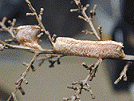The Praying Mantises
by Ronnie Ugulano

My husband was the only boy scout in his town that earned the "Insect Life Merit Badge". Even now, it's not hard to see why. He thinks bugs are cool. I on the other hand, do not do bugs at all, so it was with a little surprise when while we were going together, he told me about his pet bugs. At the time, his bug of choice was (horrors!) the Black Widow Spider, but after we were married, I was able to convince him to "switch brands". This led to his pursuing an interest in praying mantises. OK, I could go for praying mantises, just as long as they didn't get too close.
Even though I couldn't help but get rather creeped out by them, I also could not help but become fascinated by them as well. They are the kind of beneficial insect that can help you reduce insecticide usage because of their voracious appetites. There are many kinds of mantises, and as an extended family, they live over a huge area of the world. Each locality has their own type. However, the praying mantises that live in our area look like the picture in the upper right.
Once you know what to look for, you are in pretty good shape if you'd like to try raising them yourself <g>. Get a quart jar or terrarium and put a stick in it, preferably with some leaves on it. You can use plastic greenery if you want, just make sure it doesn't flap around in the jar, and that the stick stops about an inch or two below the mouth of the jar. After you have prepared your Mantis Condo, go looking for a praying mantis. In the spring, they will be small, anywhere from 1/4 inch to 1 1/2 inches. Gently get it into its new home. One warning - praying mantises can jump, so don't think that since you have caught it, it can't get away <g>. However, they won't bite you, so if it lands on you, try not to react violently.
Your suitableness of being a praying mantis parent is directly related to how many bugs you can catch for them to eat. Get a butterfly net, and a pair of Cross Action Tweezers. Any tweezers will work in a pinch, but Cross Action are best. When you squeeze on them, they open, and when you let go, they clamp. This enables you to hold on to your feeder bug without having to maintain a grip on the tweezers.
Praying mantises can eat as many as 800-1000 bugs in a lifetime, and they live about 8-9 months. Daily, a mantis can eat as many as 7 flies, but they don't absolutely have to eat every day. Two to three flies per day, for example, will do. However, how big and how fast your mantis grows is directly related to the amount of food it gets.
Baby mantis' eat aphids, and it's easiest to just drop an aphid covered flower into the jar, and soon the baby will eat them as they begin to move around.
Flies are a primary, easy source of food for a mantis, but they will also eat honeybees (please remove stinger first), lacewings, moths, some caterpillars (evidently not all taste good <g>), earwigs (remove pincers), etc. They prefer bugs with a thinner exoskeleton with juicy insides such as above, rather than beetles, roly poly's etc. If you use spiders, remember that the spider can become the conqueror instead of the victim, so be sure to stick with spiders smaller than your mantis.
For the older mantis, 1 inch big and above, use your butterfly net to capture your feeder bugs, and carefully get ahold of them with the tweezers. Praying mantises prefer their meals live, so try not to kill it. Once you have the bug on the tweezers, open the jar, and gently lower it towards the praying mantis. At first, the praying mantis will probably try to avoid it, because it is used to catching its own food, but if you use slow, gentle movements, it will learn very quickly to eat off the tweezers. It usually takes about 3 days to a week to train them.
Now that you have dietary requirements covered, how will your mantis grow? Every few weeks, depending on how much it is fed, your mantis will go through a growing spell. A clue that this is about to happen is that your mantis won't eat. Within 24 hours of this, the mantis will split its skin and step out of its old shell. Twelve hours or so later, your bug will be ready to eat again, and with a vengeance.
A praying mantis will grow about 5 or maybe 6 times before reaching maturity. Its final molt is when you can easily determine whether you have a male or female. It's possible that a real entomologist would know how to tell the difference at a younger age, but the rest of us have to wait a while.

Male mantises, at least the ones we see, are slender-built with long bodies and long antennae. The easiest thing to look for, once mature, are the long wings. A male's wings will run from just behind the head, to the end of his body or about 1/8 an inch longer.
Most males, especially at maturity, are very restless in this glass palace. Their purpose is to go and find a female, and so at this point, it would be the humane thing to let your fella go, unless you have a female handy. You know how it is, "A man will leave his father and his mother. . . "

The female's wings will go no farther than 3/4 of the length of her body, starting from below the head. She has a chubbier appearance in comparison to the male, and her antennae are shorter. You'll probably also have noticed that up to this time, she has been a perpetual eating machine. Males are always hungry, but they are more interested in being on the move than eating. The females are happier in captivity, as long as they are well fed.
Now you have a mature female. If you have caught a mature female, she is very likely already fertile. If you have raised her from a buglet, she will not be fertile. Infertile females live as much as 2 months longer than fertile females, but you may want to mate your female so you can have babies in the spring.

The mating of the praying mantis brings new meaning to the phrase "and he will stick to his wife, and the two will become one flesh", because the female almost invariably eats the male. The male usually dies within a few days of mating, so don't mourn too long over this. In any case, before putting your male in with the female, take the time to feed the female a few flies. This will keep her from eating him too soon in the wedding proceedings. If, by chance, you have 2 females, one male will fertilize both of them, assuming you can get the male out after the first mating, but this will take a few extra flies before the mating to pacify the first one.

One mating is sufficient to fertilize a female for life. A few weeks after the mating, she will lay her first egg case. It is beige, about 1" long and 1/4" tall.
Each egg case can have from 20-50 babies in it, and will emerge through holes they make in the top. They will winter over and hatch sometime from May to July, in the order each case was laid. Try to watch the hatching, if your babies will possibly be kind enough to time their hatching for a decent hour. It is a sight to see.
For the first few days, your babies will be very shy and may not eat at all, but shortly afterward, they will begin to eat each other. You will have to begin to search for aphids again, and the cycle will be complete.
It would be very difficult to enumerate all of the things we learned from raising praying mantises year after year. As well as learning about the mantises themselves, we've learned about the cycle of life and death. We've also learned much about the various prey of the mantises, such as the life cycles of flies, bees, and other insects. In addition just watching the mantis eating with its numerous mouthparts makes us appreciate their intracate design, and the wonders of Jehovah's creations.
